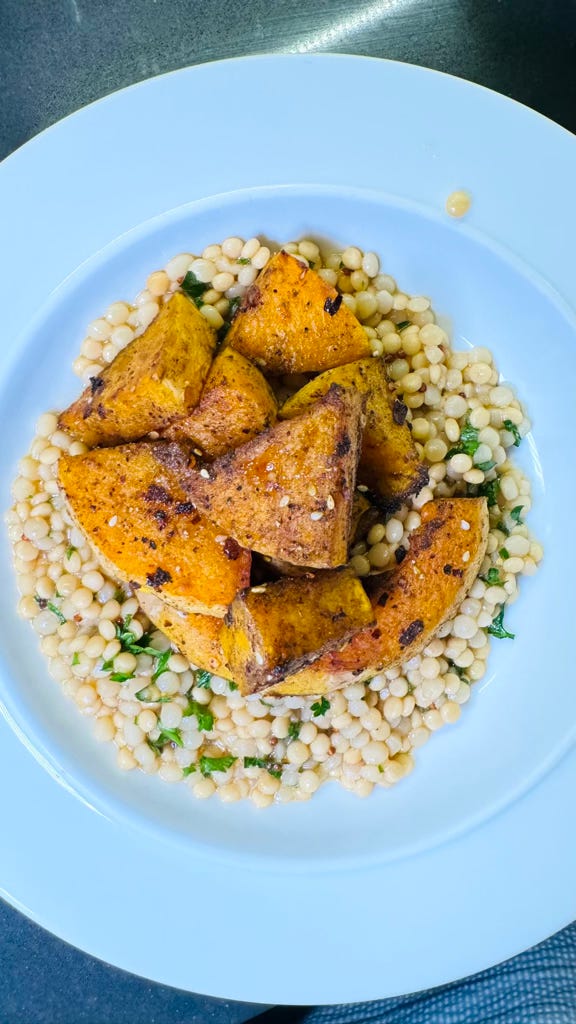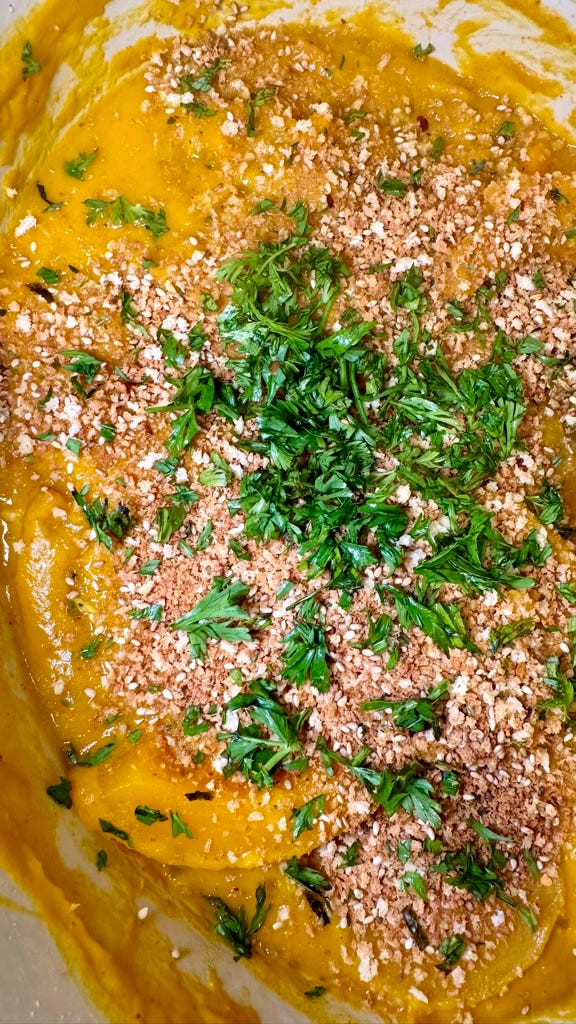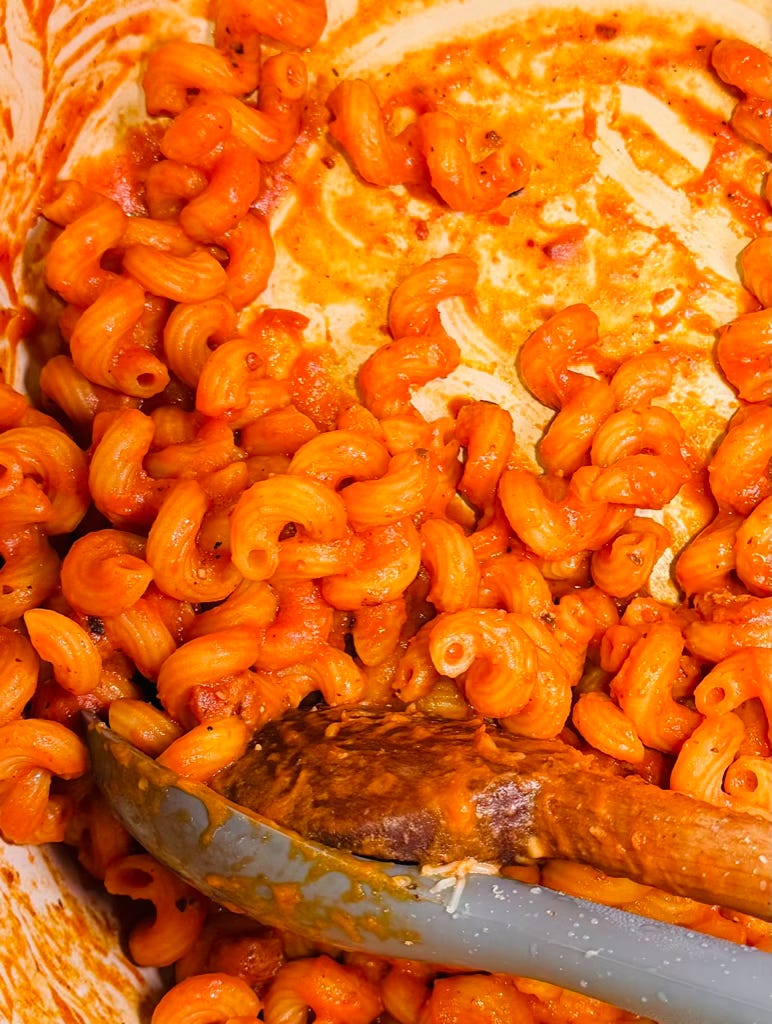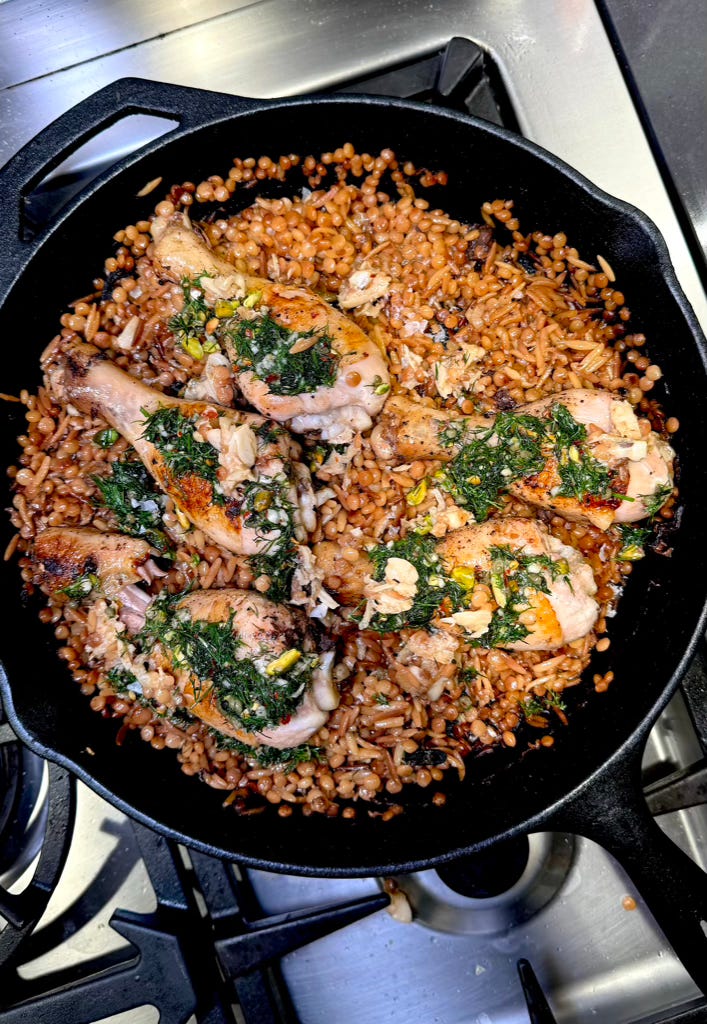We’re in October and the weather is getting chillier…in theory (I’m in LA where it’s 80 degrees, and I have no idea what sort of tropical temps global warming is bringing to the rest of the country, but let’s just go with it). Butternut squash is quietly returning to the kitchen while all those summer vegetables recede away (again, it’s LA; so not totally true, but very poetic and whimsical sounding).
The point is that the seasons are changing, and so is the cooking. But one thing that never changes? I always have a backlog of dishes I’ve made - some that even hail from June. Here are some of the hits and misses.
Butternut Squash, Two Ways
My friend Sylvia is an ardent fan of UK food writer Nigel Slater; so when I saw a compact, orange book of his in Stockholm, I sprung for it. It’s called Greenfeast, and it’s a two volume affair. One book focuses on Spring and Summer meals; the other, which I purchased, emphasizes hearty cold-times food. It doesn’t really get that frigid here in SoCal, but it’s fun to pretend; so with the days growing shorter I finally pivoted to the book and made two separate butternut squash recipes.
First, a dish simply called “Pumpkin, couscous, date syrup” for which I subbed in butternut squash The method is simple and produces excellent results - so good that Slater himself ranks it first on his list of 10 favorite recipes from the past 30 years (!). In brief: roast the squash with za’atar; cook the couscous; make a vinaigrette with date syrup, oil, lemon juice, and mustard. Mix the dressing into the couscous (with some herbs too) and top with the squash. The dish’s elegance belies its simplicity. This was absolutely excellent, and it will go in the rotation.
Onwards to squash event #2. Just a few nights ago, I embarked on Slater’s impossibly orange “Butternut, Breadcrumbs, curry powder” dish. It’s essentially a Japanese influenced curry wherein slices of squash bubble away in a stock of sauteed carrots and onions, as well as vibrant superstars curry powder and turmeric. We then blend half the liquid mixture, return it to the pot, and then top everything with bread crumbs and togarashi (which regrettably, I did not have). We’re also supposed to add parsley, but I figured I’d be clever and use chopped carrot tops instead.
This dish was also incredibly delicious, but it wasn’t an effortless feat. First, I used a Dutch oven that was too small - an impactful mistake. You really want to have room for those squash slices to spread out and submerged under the liquid. In my case, they kind of piled up in the stock, with certain pieces jutting out like rocks on a shoreline. Needless to say, there was a lot of uneven cooking, which led to doting, fretting, adjusting, and waiting.
Another tip: Slater recommends cutting the squash into 2cm slices, which look dramatic and st, but I’d halve those pieces crosswise - just to speed along the cooking process.
Lastly, the curry was enjoyable but needed a little something. Acid, perhaps? I added some vinegar - maybe about a tablespoon or so? - just to give it a little depth of flavor. I highly recommend this move. Really made it sing.
In the end, both dishes were a hit, and they’ll be back to the table soon enough.
Pasta Alla Vodka
A recent edition of Cook’s Illustrated has a recipe for pasta alla vodka whose selling point sold me: “Everybody wants to cook pasta alla vodka.” Can’t argue with that. Writer Steve Dunn explains that the CI team sends recipes out to at-home testers before publication, and that this pasta alla vodka not only generated the most interest but had the testers “swooning over it.”
I like to swoon! Why not me?? And so I set about making Steve Dunn’s Pasta Alla Vodka. The testers were right: it was swoon-worthy. So good I made it twice in one week. Here are some takeaways:
Dominique, my boyfriend, is lactose intolerant; so I used full-fat coconut milk instead of heavy cream, and the difference was negligible. There are such strong flavors in the dish that the subtle coconut undertones were barely detectable. And if they had been stronger, I’m not sure it would have been such a bad thing. Might have tasted a bit Brazilian! Anyway, keep this in mind if you’re avoiding dairy.
Second, from start to finish this pasta took 43 minutes both times. Not bad.
Third… there is no third. I thought I had more takeaways. This is a great dish.
FYI, if you’re a real pasta alla vodka fiend and have more time on your hands, I also recommend Colu Henry’s excellent smoky garganelli spin on it.
One-Pan Garlicky Chicken Couscous
Recently, when leafing through books at the local cookbook store Now Serving, someone told me that “of the latest crop of cookbook girlies, Carolina Gelen is at the top of the class.” It really moved the needle for me. Now I’m the proud owner of Pass the Plate by Ms. Gelen, a veritable child who somehow has 1.3 million followers on Instagram (might be a good time to hawk my IG: @benmandelker and @nbdfancy).
The first recipe I attempted from Gelen’s book was this chicken, which is browned in a skillet before being cooked over a bed of couscous in the oven — very top of mind after Slater’s aforementioned “pumpkin, date syrup, couscous” recipe. While the chicken bakes, we assemble a zingy topping of dill, capers, and garlic that we scatter across the finished dish. Dominique is caper-adverse; so I only added enough to bring a dab of brininess. I filled out the topping with some pistachios because it plays well with dill and also why not? The crunch worked very well amidst the fluffy couscous.
Okay, well, this was phenomenal. The couscous soaked up all that chicken goodness (aka fat) while the herb sauce leant essential balance, cutting through the heaviness with a sharp bite. And did I mention the fifteen cloves of garlic that we tucked into the couscous? By the time the pan emerged from the oven, the garlic was soft and sweet. We were meant to scoop it out and crush it over the whole dish, but I left about half of it in the pan and just mashed it with a spoon and mixed it into the madness. I recommend you do the same.
Notably, we’re supposed to broil the chicken at the end of the process in order to get some lovely char, but my drumsticks (I couldn’t find thighs - ugh) appeared to be on the verge of drying out; so I skipped the step, and honestly, it was fine. If you find yourself in a similar situation, prioritize juicy chicken over photogenic browning.
Chickpeas Alla Vodka
Gelen’s chicken was such a success that I dove right back into the book, this time tackling her legume interpretation of pasta alla vodka (also top of mind, courtesy of Cook’s Illustrated ). Whereas Dunn employs both tomato passata and paste to build his dish’s vodka sauce, Gelen only uses tomato paste - and significantly less vodka. Unsurprisingly, things went a little sideways with this dish.
First, I burned my shallots, which leant the dish a bitter undertone. My bad.
Second, I used coconut milk again, but the brand I used was much thinner, so everything felt significantly “wetter” than when making the pasta version.
Together, the burnt shallots and coconut milk took this dish to an unplanned place. The shallots turned the sauce brown, and without a strong tomato or vodka presence, the coconut milk really took center stage. Basically, I had made an accidentally curry, which is not always an outcome you strive for with an Italian adaptation. I decided to just lean into it. With some seasoning and other adjustments, I was able to tone down the bitter burnt shallot notes and wind up with a dish that tasted not at all or even close to pasta alla vodka. And that’s okay! My brown mess was very tasty on its own terms, and a few days later, when I had the leftovers on a slice of garlic toast, they were downright delicous. I’d like to give this a second try and not mess it up.
“Chickpea Thing”
I was really excited to try Gelen’s chickpea alla vodka recipe because I cook a lot of chickpeas these days - or garbanzo beans, for those who like to be formal about it. One dish I made recently was so good that I jotted it down as “chickpea thing,” as if that would spark my memory for years to come.
Well, my friends, I have no idea what “chickpea thing” is, but I have two guesses.
In September I threw together a random assortment of items: celery, onion, Jimmy Nardello peppers, garlic, ground pork, fennel seeds (mandatory whenever pork is invoked), chickpeas, and tomato paste. Oh, and diced tomatoes. And basil! And parm!
This really went in many directions at once, and somehow it was amazing. Sweet, savory, warming - all the things. Was it a chili? Had a made a chili? Whatever it was, it felt like something I should make again. Second time around I added too many tangy tomatoes, throwing the whole thing off balance. I plan to work on this dish and report back with a proper homemade recipe (one step closer to my cookbook ambition!).
But maybe “chickpea thing” referred to a novel assemblage of refrigerator stragglers I shoved together a few weeks ago. First I “frizzled” some chickpeas in a pan. Then roasted some old carrots in the air fryer. And then, since it’s important to have three different cooking methods firing off at once for no good reason, I boiled some farro on the stove. While everything cooked, I took some homemade green sauce and made a verdant landing pad on a serving plate. I topped it with the farro, then the carrots, and then the chickpeas.
And as a firm rebuke to the concept of editing, I drizzled some sort of quick tahini sauce over the top. Probably didn’t need to do that, but the sink looked like it wanted to cradle some extra dishes. This was an excellent vegetarian meal. In fact, this was an excellent meal period - vegetarian or not.
I’m still not sure what dish “chickpea thing” referred to, but I’m delighted with both outcomes.
Sticky date and ginger cake with coconut-rum sauce
I cannot emphasize enough how amazing this cake was from Everyday Cakes, a book that churns out banger after banger after banger. (My friends Matt and AJ recently baked the roasted pumpkin spice cake with tahini glaze from Everyday Cakes, and it was irresistible). I brought this puddle-bound date cake to a brunch, and I kid you not, it was entirely gone in the span of about 8 minutes. YOU DO NOT EVEN KNOW. However mouthwatering the photo looks, just amplify that by 10, and you will understand this incredible cake.
Peperonata
I’m a recent convert to the Jimmy Nardello pepper, a gnarled, red-green capsicum with a beautifully sweet flavor. They’re only available for, like, 3 days a year; so when I saw them at the farmer’s market, I bought a giant bagful. The plan was to cook some off and freeze the rest, which was so adorably ambitious. In reality, the bag sat in my fridge for close to three weeks, pepper guilt slowly gnawing away at me every day.
I decided to convert the Jimmy Nardellos into a peperonata, which is essentially a sweet-tangy Italian pepper relish (think caponata but swap out the eggplant for peppers). There were many tempting peperonata recipes in my cookbook collection, but ultimately I opted for Joshua McFadden’s take from Six Seasons. His stuff always turns out well, and also, his recipe allowed me to use up some random cherry tomatoes I had loitering in the kitchen.
The process involves a lot of deseeding, sauteeing, browning, swirling, and other exciting endeavors. None of it was very hard, but it did take more time than I had expected. I thought it would be a 60 minute, largely hands-off effort, but I believe it took closer to 2 hours. Nevertheless, the end product was lovely, and I continue to use it in all sorts of fun ways: on toast, over eggs, in pasta (my favorite so far). If you have a bunch of peppers staring you down furiously, this is a great way to batch cook them. The copious use of vinegar in the peperonata also means that it can last in the fridge for a very long time.
Briefly…
This is going long, and Substack will yell at me for using too many words. So, briefly, here are some other things I’ve made. Claire Saffitz’s honey-roasted apple cake. I liked this but wanted it sweeter. I’ve discovered that when it comes to apple cakes and pies, I like to go full throttle sweetness, which is very unhip. No Granny Smiths for me! Nevertheless, I brought this cake to a Rosh Hashanah dinner, and everyone lost their minds over it. “I love that it’s not TOO sweet!” was the most common feedback. Go figure.
Ina Garten’s 1770 House Meatloaf: I’m a loyalist to Ina’s wonderful turkey meatloaf, but I thought I would try this meatloaf remix. Delicious, albeit very rich. The garlic sauce is a wild departure from the usual ketchup topping one might find. My rec: double the amount of sauce because you’re going to want to slather it all over.
Ina Garten’s creamy parmesan polenta: simple, delicious, lovely.
Ben’s improvised homemade polenta topped with Swiss chard: wet, sad. Ended up in the garbage (which was a shame since the chard was actually perfect, but the polenta was a disaster).
Caramelized fennel with orzo and saffron water from the Ottolenghi Test Kitchen: Extra Good Things. A real showstopper on the table, and thankfully, delicious too. Really enjoyed this.
Alison Roman’s Scallops with corn, hazelnuts, and brown butter chermoula was striking on the plate, but I oversalted the scallops and ruined everything. What a shame. As a concept, excellent. In execution, it was an execution. And I was the executioner. Better luck next time.
What have you been making lately that has been noteworthy? Any hits and misses?











Bennnn!! I wrote down so many recipes to try - can’t wait! Here’s one (butternut squash pasta with bacon and parm) a friend made for me recently that was v delicious https://cooking.nytimes.com/recipes/1021510-butternut-squash-pasta-with-bacon-and-parmesan?smid=ck-recipe-iOS-share
I’ve also been digging this salad I’ve been making for lunch that’s sort of fall inspired: spinach, roasted sweet potatoes, avocado, pepitas/walnuts/or both, any fresh herbs you like, pomegranate arils, blanched green beans, and a dressing of maple syrup, lime juice, and evoo.